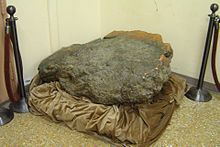- Ontonagon Boulder
-
The Ontonagon Boulder is a 3,708 pound boulder[1] of native copper originally found in the Upper Peninsula of Michigan, United States, and now in the possession of the Department of Mineral Sciences, National Museum of Natural History, Smithsonian Institution. The boulder is a relic of the mining rush to the Michigan Copper Country, and was well known to Native Americans in its location on the west branch of the Ontonagon River, in what is now Victoria Reservoir. According to the Keweenaw Bay Indian Community, the boulder was used by tribe members to make offerings to its manitou (spirit) and to seek improvement in their health and well-being.[2]
Contents
The boulder's history
In the early seventeenth century, Voyageurs traversing Lake Superior heard word of the massive solid copper boulder. In 1667, the redoubtable Jesuit missionary Claude Dablon made his way up the Ontonagon and confirmed the existence of the fabled rock.
A century later, under the guidance of a party of Ojibwe, trader Alexander Henry laid eyes on the rock, and reported that he found it to be so pure and malleable that he was able to easily remove a large piece, and estimated the boulder's weight at ten tons. In 1819, during his geological survey of the area, Henry Schoolcraft reported that he found the rock to be scarred by the chisels and axes of Native Americans, and estimated its copper content at one ton.[3]
Rights to acquire and remove copper from the Ontonagon area were ceded to the United States in 1826 (Treaty of Fond du Lac) and in 1842 (Treaty of La Pointe). Prior to extracting the boulder in 1843, Julius Eldred paid a sum to the head man of the Ontonagon for the privilege. The boulder was removed from the south fork of the Ontonagon River in 1843 by Mr. Eldred and transported to Detroit, Michigan, where it was confiscated by the War Department. It was taken to Washington, D.C., and remained in the possession of the War Department until 1860, when it was transferred to the Smithsonian Institution.[2]
The boulder today
In 1991 an assessment was initiated after a request was received from the Keweenaw Bay Indian Community for the return of the Ontonagon boulder as a sacred object. A preliminary analysis indicated that the tribe presented insufficient evidence to establish that the boulder fits the definition of sacred object under the Native American Graves Protection and Repatriation Act. Consultations were held with the tribe in 1998 and 1999, including a visit to the area in which the boulder was originally located. In 2000, it was recommended by the Repatriation Office that the Ontonagon boulder does not fit the definition of sacred object under the repatriation law, and the right of possession belongs with the Smithsonian Institution.[2]
As of 2011, the Ontonagon boulder is located in the National Museum of Natural History, but it is currently behind the scenes. It was to be installed in the Hall of Geology, Gems, and Minerals when they opened, but at the last minute, engineering concerns led to a veto. A new exhibition of the Boulder is being planned.
A replica of the Ontonagon boulder can be found at the Ontonagon Historical Museum.[4] While various numbers are given for the boulder's weight, the most commonly accepted figure is 3,708 pounds. [5]
References
- ^ http://www.docentguild.org/TidBitsIndex.php?parm1=10
- ^ a b c Executive Summary Assessment of a Request for the Repatriation of the Ontonagon Boulder by the Keweenaw Bay Indian Community
- ^ Ontonagon Light: Historical Information
- ^ Ontonagon Historical Museum
- ^ http://www.docentguild.org/TidBitsIndex.php?parm1=10
See also
Categories:- Geology of Michigan
- Ontonagon County, Michigan
Wikimedia Foundation. 2010.

